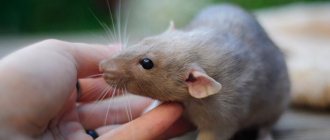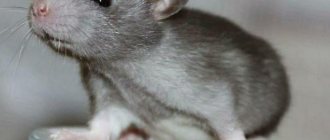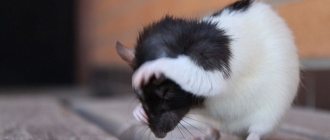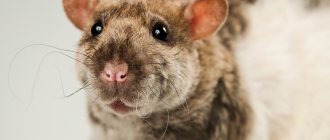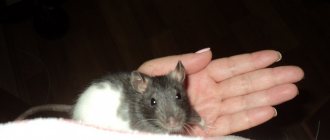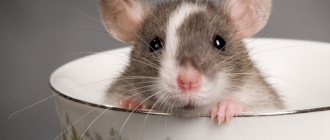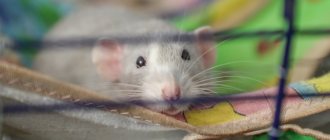The hairless decorative rat, as the name suggests, is a rat without hair. She looks just like any other rat, but instead of brown, white or black fur, she only has soft pink skin.
In fact, this animal is not completely naked. Some individuals, along with the bare pink surface of the skin, have areas of short dark hair along the body.
Description of a hairless rat
The Hairless breed was created in 1932 by mutation. The reason for the appearance of an unusual rodent was simple human curiosity. The animal is called the Sphinx rat, naked rat and bald rat . This is a rather rare phenomenon, which is distinguished by a hairless body, bright pink translucent skin, and a mustache of standard length.
Here are some interesting facts that clearly describe the bald man.
- He has a friendly character and a great mind. The pet expresses its affection in an interesting way. For example, he licks the owner’s hands. The temperament of an animal is determined by genetics.
- Lives up to 3 years, and with proper care - up to 5 years . Often these individuals die very early due to various diseases and human negligence.
- The body size of adult rats ranges from 15 to 25 cm, and body weight ranges from 350 to 700 g.
- The true Sphinx has bright pink skin, without scars or spots. It is soft and velvety to the touch. A slight folding of the skin gives the pet solidity and attractiveness. Today you can find hairless rats that are black, blue, chocolate, gray or cream in color.
- Vibrissae are located on the cheeks and above the eyes. The mustache curls slightly downwards, forwards or backwards. The size of the antennae is small when compared with the whiskers of standard rats. Some individuals do not have a mustache, which is considered a genetic deviation.
- Baldies are endowed with large, wrinkled, low-set ears. The eyes are bright and can be black, red, ruby, husky, or pink. There are individuals with different eye colors.
There is no hair. The recessive hairless gene is not observed in all rats. More often, individuals have partial hair.
Rats within the breed are divided into subspecies, depending on the areas of baldness, the shape and length of the whiskers:
- Hairless - hairless;
- Naked - naked;
- Fuzzy – fluffy;
- Nude - naked;
- Shorn – shorn;
- Bald - balding.
After birth, the offspring acquire a thick coat of fur. The fur coat is gradually falling out. It is possible to determine the subspecies of the animal only until the sixth week of the cub’s life.
Advantages and disadvantages of the breed
The hairless rat will be an ideal pet for children, lonely people and allergy sufferers. The main advantages of the breed are highlighted:
- absence of unpleasant odors;
- sociability, affection for a person;
- interesting external data;
- hypoallergenic properties;
- good mind.
Disadvantages include low life expectancy. The rodent will wither if left alone .
Character
Hairless rats are very active, curious and peaceful creatures; they quickly become tamed and become attached to their beloved owner. The lack of fur obliges the owner of a bald pet to hold his little friend in his arms as often as possible, stroke, kiss the fluffy rodent, carry it in his bosom and on his shoulder. The warmth of the human body warms and calms naked animals; in response, the animal does not skimp on showing tender affection and sincere feelings.
Sphinxes very sensitively sense negative intonations in the owner’s voice; fright from a sharp cry can cause a stroke in these gentle animals. A person should communicate with babies in a gentle and friendly voice; rats instantly respond to the owner’s name and greetings, enjoying close communication and fun outdoor games.
Sphynxes are particularly clean; while walking, adults do not dirty the territory, but try to do all their toilet chores in their cage.
Varieties of Sphinx rats
Sphinx on standard
This species was obtained by mutation and crossing of ordinary standard breed rats. Sphynxes have long mustaches and sparse hair on their heads, paws and sides. The animal's soft pink skin is intertwined with coarse dark hair. A distinctive feature of the animal is the presence of circles around the eyes . Rat breeders call them “porcupines” and “spectacled rats.”
Sphinx on a rex
The breed's hairless coats are descended from rodents with curly fur. Uniqueness lies in the presence of curled mustaches, sparse wavy hairs on the head, limbs and groin. Hair is absent during the molting period.
Sphinx on Double Rex
They are a sought-after breed of rat. Individuals are distinguished by completely hairless pink wrinkled skin. Bright eyes and large ears give the rodent a mystical appearance.
General health problems
Hairless rats have more potential health problems than their regular counterparts. They freeze quickly, and the lack of fur makes their skin extra sensitive. Some things that wouldn't bother a normal rat can scratch, cut, and otherwise irritate a hairless rat's skin. Despite the absence of hair, the animal has hair follicles. Sometimes they become clogged and form pimple-like bumps on the skin.
If not treated promptly, these bumps can become inflamed and cause an infection, which is likely to result in the death of the animal. The hairless rat has a weak immune system. Bacterial infections and other diseases are much more dangerous for her than for her ordinary counterparts.
With proper care and in almost ideal conditions, a hairless rat will live for about one year. The rat has such a short life because its body is unable to resist infections.
Rules for keeping a Sphinx rat
Place
The ideal place for a bald animal would be a large, cozy cage. Place the house in a secluded corner. It is important to exclude exposure of the rodent to drafts and sharp objects.
Correct temperature
The temperature in the room should be from +25 to +28 degrees.
Important! Dry air and too high temperatures destroy your pet's skin. It is recommended to humidify the room daily with spray bottles or special humidifiers.
Choosing a pet cage
To properly arrange a home for the Sphinx, just use these tips:
- buy a wire cage measuring at least 60x40x60 cm, equipped with a high plastic tray, a solid bottom and wide doors;
- an aquarium will create safer living conditions;
- inside the cage there is a swing, sticks, a wheel and a small house;
- large sawdust, white paper or cardboard are used as filler;
- a feeder and a drinking bowl are placed.
Before placing a pet in a new home, the cage is carefully inspected for damage and sharp corners.
Attention! It is not recommended to purchase a cage made of plastic or similar materials. After cleaning and disinfection, the material will be damaged and will release hazardous substances.
Cleaning
Clean the home once a week. The Sphinx is placed in a safe place so that the cage can be treated with disinfectants. After completing the procedure, rinse the house thoroughly under running water and dry. The drinking bowl and feeder are washed every day.
Do you groom the cage once a week?
Mandatory hygiene
Bathe your bald head once every few months. The frequency of water procedures depends on the cleanliness of the rodent. If your pet gets very dirty with food, you can bathe it once a week.
The container is filled with warm water and the rat is carefully placed in it. It is prohibited to use soap, shampoos, and other detergents. After washing, dry the Sphinx with a towel.
Hygienic procedures include trimming the claws. Special scissors and pruning shears are sold at pet stores. If a rat's claws are too long and sharp, it will scratch the other inhabitants of the cage.
Feeding
Hairless rats are barked often and in small portions. The Sphinx's favorite food is various nuts, vegetables and fruits. You can buy special food. You should not give your pet cheese, salty or fatty foods.
Group content
Sphinx lovers are advised to get a same-sex pair of animals at the same time. They will warm themselves against each other. Several individuals get along well in one area.
Important! Keeping a large number of hairless rats will not be difficult. One group is placed in a cage at a time. If pets are purchased in addition, it is better to place them in another cage. This will eliminate the aggressive behavior of the house owners towards new rats.
Communication
The Sphinx rat needs constant communication and games with its owner. Walk your pet in a safe room. The bald one will hide in the warm hands of a person and will closely observe the environment. If you trim the claws in a timely manner, the animal will not scratch its knees or shoulders while climbing.
Advantages and disadvantages of the breed
The hairless pet rat is rapidly gaining popularity and this is due to a fairly large list of advantages compared to disadvantages. This pet is ideal for families with small children, as well as for people with allergies.
How much does a pet rat cost - cost of keeping
The main advantages of the breed and keeping the rodent:
- The hairless rat breed is completely hypoallergenic. That is why people who are prone to developing allergic reactions due to fur should pay attention to rats.
- Animals have a good disposition, so people living with them receive a lot of positive emotions. They are pleasant to the touch and really love to spend time in the arms of their owners.
- The process of adaptation to a new home takes a short period of time, since the animals quickly become attached to new people and crave communication with them. An interesting feature of the life of bald rat pups is that they love to watch the life of their household members from above, climbing onto their shoulders.
- Due to the lack of fur, the animals do not emit a pleasant smell, and they are also very clean animals. The main thing for the owner is to regularly clean the “rat” toilet.
- Decorative rats love water very much, so they will happily swim in warm water. Do not use additional detergents.
- Caring for hairless rats has no fundamental differences in comparison with ordinary breeds of these animals. Perhaps the only condition is that due to the lack of wool, the room must have an optimal temperature range, ranging from +22 to 30 degrees. If several pets live in a cage, the temperature may be slightly lower.
Note! It has been scientifically proven that Sphynx rats are smart and easily remember their name and the names of other pets. Remember the names of all household members.
Appearance of Sphynx rats on a rex
As for the disadvantages, it is worth noting only their short life expectancy. Hairless rats also quickly waste away when left alone.
Breeding and reproduction
The Sphinx reaches maturity at 5 weeks of age. The young female is ready to mate 100 days after birth. The duration of pregnancy is 25 days. Hairless rats reproduce well: 8 to 12 pups are born in a litter. Zoologists recommend contacting a veterinarian before breeding Sphinxes.
The hairless rat cannot boast of maternal instincts. The owner must carefully monitor the mother's behavior. If she refuses to feed the offspring, then the owner must independently feed the pups with a special mixture.
Nutrition and diet
Rats love to eat and, as a result, will, of course, overeat if given the opportunity. They can become overweight and fat extremely quickly. It is important to carefully choose food for your pet friend and monitor the amount of food eaten.
The hairless rat looks cute even when he's a little chubby, but his health is at stake in this matter. Hairless rats eat the same food as normal rats. Choose a food that will provide your pet with the vitamins and nutrients it needs to stay healthy.
Fruits are a treat and hairless rats certainly love them. They even enjoy vegetables and nibble on them from time to time. Offering your rat a few pieces of fresh fruit and vegetables every day will help keep him in good health and enjoy variety.
Health and illness
Sphynx rats are susceptible to:
- acute respiratory diseases - the pet makes sounds similar to coughing;
- abscesses – purulent formations on the skin are observed;
- cardiovascular diseases - the animal is weak and inactive, obesity appears;
- skin diseases - there are rashes, wounds and scabs on the body;
- benign tumors and oncological diseases - the animal languishes, refuses food and drink.
After birth or purchase, the hairless rat is taken to the veterinarian. If minor deviations in the pet’s behavior are observed, it is important for the owner to immediately contact a specialist.
How to choose a cage?
A rat needs a cage because it needs a place to roam and play! It is important to choose a cage in which the animal will not be exposed to danger. There should be no sharp objects that could injure the pet. Size is also important: for one animal you need at least 70 cm, and for two, respectively, 140 cm.
Comfortable living conditions
The Sphynx is a breed that is sensitive to the effects of heat and ultraviolet radiation, especially in the head area. Therefore, her cage should not be in direct sunlight.
Cell selection
The pet's cage should be spacious and large enough. There is no need to leave sharp objects near it and avoid direct sunlight. Hairless rats grow hair solely due to the activation of the body's protective functions. Create good conditions and the “fouling” problem will be solved!
Cleaning the cage
Speaking about sphinxes, it should be noted that they are quite clean creatures. During cleaning, you need to remove garbage from the cage, wash and disinfect the surface. This will not only get rid of the rodent smell in the house, but also prevent many diseases.
Features of feeding
Most often, owners of hairless rats choose the most convenient way of feeding their pets - industrial grain mixtures.
Animals of this breed require a balanced diet of premium quality.
You can feed rats natural food, but at the same time:
- Avoid fatty foods.
- From time to time, add boiled fish, pieces of boiled meat, and boiled chicken bones to the diet.
- Regularly enrich your diet with vitamins.
Hairless rats should eat fractional meals. They need to be fed little and often. Sick animals should include special foods in their diet that act as natural antibiotics.
Table 2. Products for Sphynx rats
| Prohibited | Allowed with restrictions | Allowed/helping to recover from illness |
| Beans | Sour cream (once every 7–9 days) | Ripened bananas |
| Beans | Hard cheese (2–3 times a week) | Raspberries |
| Chocolate | Cookies (once a month) | Garlic |
| Raw potatoes | Sunflower and pumpkin seeds (2 pieces per day) | Eggplant |
| Cabbage | Sausage (once a month) | Tea infusion (with Echinacea) |
| Spinach | Bulb onions | |
| Unripe bananas | ||
| Carbonated drinks | ||
| Milk | ||
| Juices |
Attention! Salty and smoked foods, as well as sweets, must be excluded from the diet of hairless rats.

